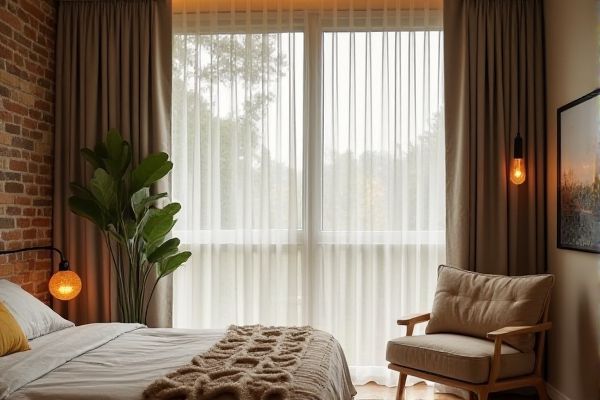
Privacy screens offer a rigid, portable solution for creating personal space in shared environments, while privacy curtains provide flexible, inexpensive coverage that can be easily drawn or retracted. Explore the differences between privacy screen and privacy curtain to determine which option best suits your privacy needs.
Table of Comparison
| Feature | Privacy Screen | Privacy Curtain |
|---|---|---|
| Purpose | Blocks visual access on digital devices | Provides physical privacy in spaces |
| Material | Polarized film or mesh | Fabric, often opaque or semi-opaque |
| Usage | Attached to monitors, smartphones, laptops | Used in hospitals, offices, homes |
| Privacy Type | Digital screen privacy | Physical space privacy |
| Portability | Highly portable and lightweight | Less portable, requires mounting |
| Visibility Control | Limits viewing angles to prevent side glances | Blocks view to create private areas |
| Cost | Moderate, typically $10-$50 | Varies widely, $20-$200+ |
| Installation | Simple peel-and-stick or clip-on | Requires curtain rod or track installation |
Introduction to Privacy Screens and Privacy Curtains
Privacy screens and privacy curtains both serve as effective barriers to enhance personal and professional privacy in various settings. Privacy screens typically consist of rigid panels made from materials like acrylic, glass, or fabric, designed to block visual access while maintaining airflow and light transmission. Privacy curtains, made from opaque or semi-opaque fabrics, offer flexible, easy-to-install solutions that can be drawn or retracted to create private spaces, making them ideal for medical facilities, offices, and homes.
Key Differences Between Privacy Screens and Privacy Curtains
Privacy screens offer a rigid, often portable barrier made from solid materials like acrylic or tempered glass, providing durable, easy-to-clean protection ideal for offices or medical environments. Privacy curtains are fabric-based, flexible solutions that hang from tracks or rods, allowing for customizable coverage and easy movement in hospitals or shared living spaces. Your choice depends on the need for permanence, maintenance preference, and the environment's specific privacy requirements.
Material and Durability Comparison
Privacy screens are typically made from rigid materials like acrylic or polycarbonate, offering enhanced durability and resistance to impact, making them ideal for long-term, stable installations. Privacy curtains use fabric materials such as polyester or vinyl, which provide flexibility and easy installation but tend to wear out faster and may require frequent cleaning or replacement. The choice between these depends on the need for sturdiness versus versatility in different privacy settings.
Installation and Setup Process
Privacy screens typically involve a straightforward installation process, often requiring adhesive strips or mounting brackets to attach directly to windows or monitors, making them a quick and hassle-free option. Privacy curtains, on the other hand, require a more involved setup that includes installing curtain rods or tracks, which may need drilling or professional assistance depending on the window frame and wall material. The choice between the two depends on the level of permanence desired and the complexity the user is willing to handle during installation.
Design and Aesthetic Options
Privacy screens offer a sleek, modern design with a variety of materials such as frosted glass, metal, or acrylic, making them ideal for contemporary office or home settings. Privacy curtains provide more flexible aesthetic options with diverse fabrics, colors, and patterns, allowing customization to match any interior decor or create a cozy, soft ambiance. Your choice depends on whether you prefer the clean lines and minimalism of screens or the warmth and versatility of curtains.
Space Efficiency and Flexibility
Privacy screens offer superior space efficiency with their compact, foldable design that fits easily into small areas or corners, making them ideal for limited spaces. Privacy curtains provide greater flexibility by allowing full enclosure and easy movement along tracks or rods, accommodating varied room layouts and privacy needs. Your choice depends on whether maximizing space or adaptable coverage is the primary priority.
Maintenance and Cleaning Requirements
Privacy screens generally require straightforward maintenance involving regular dusting and occasional wiping with a damp cloth to prevent smudges and fingerprints, making them low-maintenance compared to privacy curtains. Privacy curtains need more frequent cleaning due to fabric exposure to contaminants, often requiring machine washing or dry cleaning depending on the material, which can increase upkeep time and costs. Selecting between the two should factor in the ease of cleaning and maintenance frequency dictated by the specific environment and usage patterns.
Cost and Budget Considerations
Privacy curtains generally present a more cost-effective option compared to privacy screens, making them ideal for tight budgets due to their lower initial purchase price and ease of installation. Privacy screens, while often more expensive upfront, offer durability and reusability that can reduce long-term costs in settings requiring frequent repositioning or enhanced privacy. When planning your privacy solutions, consider both the immediate expense and the maintenance costs to find the best balance for your budget.
Common Uses and Best Applications
Privacy screens are commonly used in office spaces and healthcare settings to block visual access to computer monitors or sensitive information, providing a focused and secure environment. Privacy curtains work best in medical facilities, hospitals, or changing areas where physical separation and temporary privacy for individuals are required. Your choice depends on whether you need screen-based confidentiality or physical partitioning for privacy.
Choosing the Right Privacy Solution for Your Needs
Privacy screens offer a sleek, portable option ideal for office desks and electronic devices, providing targeted visual protection without compromising space. Privacy curtains deliver versatile, full-room coverage suitable for medical, residential, or commercial environments, allowing customizable privacy with easy installation and fabric choices. Selecting between a privacy screen and curtain depends on your specific privacy requirements, spatial constraints, and the desired level of flexibility.
 homyna.com
homyna.com